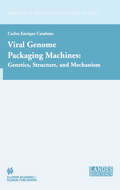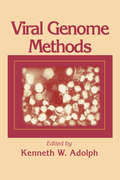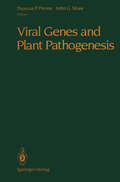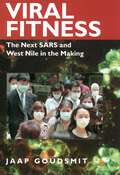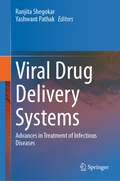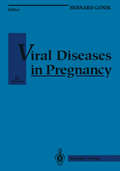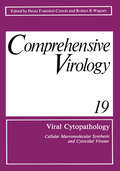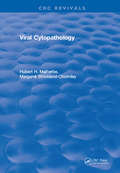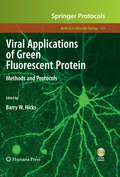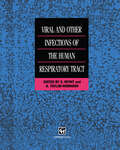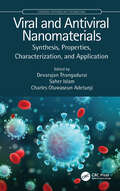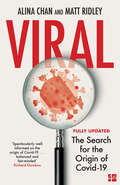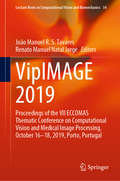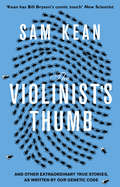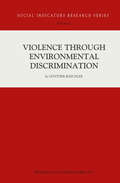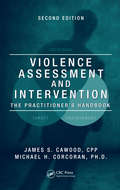- Table View
- List View
Viral Genome Packaging: Genetics, Structure, and Mechanism (Molecular Biology Intelligence Unit)
by Carlos E. CatalanoViral Genome Packaging focuses on the process of genome "packaging" within a pre-formed viral procapsid. The chapters of this book concentrate on the biochemistry, enzymology and structural aspects of the genome packaging machinery. This book defines a broad mechanistic basis for the process across the prokaryotic and eukaryotic border, and for DNA and RNA viruses. The biochemical, biophysical and structural aspects of genome packaging are examined in detail.
Viral Genome Methods
by Kenneth W. AdolphMolecular biology and genetics techniques now dominate viral research in attempts to cure diseases such as AIDS. Viral Genome Methods is a practical guide to the newest molecular techniques, providing step-by-step protocols to be used in the laboratory. Recognized authorities and pioneers in viral research pass on their expertise to you.
Viral Genome Methods
by Kenneth W. AdolphMolecular biology and genetics techniques now dominate viral research in attempts to cure diseases such as AIDS. Viral Genome Methods is a practical guide to the newest molecular techniques, providing step-by-step protocols to be used in the laboratory. Recognized authorities and pioneers in viral research pass on their expertise to you.
Viral Genes and Plant Pathogenesis
by Thomas P. Pirone John G. ShawThe chapters in this book represent detailed versions of papers presented at the Symposium on Viral Genes and Plant Pathogenesis held at Lexington, Kentucky on October 16 and 17, 1989. In selecting topics and authors, we attempted to have represented a spectrum of systems which are at the forefront of research on plant virus genes and gene products, particularly as they relate to plant disease. The book also contains pertinent discussion of the papers presented at the symposium, as well as summaries, observations and projections of future research directions prepared by the session chairmen. We wish to express our appreciation to Dr. D. L. Davis, of the RI. Reynolds Tobacco Company for suggesting the organization of the Symposium and the publication of the proceedings, and to the R 1. Reynolds Tobacco Company for the financial support which made the symposium possible. We also wish to thank those of our colleagues in the Department of Plant Pathology, University of Kentucky, who very ably and in many ways contributed to the organization and conduct of the conference. Thomas P. Pirone lohnG. Shaw v Contents Preface . . . . . . . . . . . . . . . . . . . . . . . . . . . . . . . . . . . . . . . . . . . . . . . . . . . . . . . . . . . . . . . . . . . . . . . . . . . . . . . . . . . . . . . . . . . . . . . . . . . . . . . . . . . . . . . . . . . . . . . . . . . . . . . . . . . . . . . . . . . . . . . . . . . . . . . . . . . . . . . . . . . . . . . . . . v Contributors . . . . . . . . . . . . . . . . . . . . . . . . . . . . . . . . . . . . . . . . . . . . . . . . . . . . . . . . . . . . . . . . . . . . . . . . . . . . . . . . . . . . . . . . . . . . . . . . . . . . . . . . . . . . . . . . . . . . . . . . . . . . . . . . . . . . . . . . . . . . . . . . . . . . . . . . . . . xi INDUCTION OF HOST GENES BY THE HYPERSENSITIVE RESPONSE OF TOBACCO TO VIRUS INFECTION J. F. Bol, C. M. A. van Rossum, Bl. C. Cornelissen and H. J. M. Linthorst . . . . . . . . . . . . . . . . . l COAT PROTEIN MEDIATED RESISTANCE IN TRANSGENIC PLANTS Roger N. Beachy . . . . . . . . . . . . . . . . . . . . . . . . . . . . . . . . . . . . . . . . . . . . . . . . . . . . . . . . . . . . . . . . . . . . . . . . . . . . . . . . . . . . . . . . . . . . . . . . . . . . . . . . . . . . . . . . . . . . . . . . . . . 13 STRUCTURE AND FUNCTIONS OF TOBACCO MOSAIC VIRUS RNA Yoshimi Okada, Tetsuo Meshi, and Yuichiro Watanabe . . . . . . . . . . . . . . . . . . . . . . . . . . . . . . . . . . . . . . . . . . . . . .
Viral Fitness and Evolution: Population Dynamics and Adaptive Mechanisms (Current Topics in Microbiology and Immunology #439)
by Esteban Domingo Peter Schuster Santiago F. Elena Celia PeralesThis book unifies general concepts of plant and animal virus evolution and covers a broad range of topics related to theoretical and experimental aspects of virus population dynamics and viral fitness. Timely topics such as viral mechanisms to cope with antiviral agents, the adaptability of the virus to new hosts, emergence of new viral phenotypes, and the connections between short- and long-term virus evolution are included. By comparing plant and animal viruses, universal mechanisms responsible for fitness variations, viral emergence and disease mechanisms are explored. Although emphasis is put on specific plant and human viral pathogens, relevant similarities and differences to other viruses are highlighted. Additionally, readers will learn more about the adaptability of coronaviruses, including the recently emerged SARS-CoV-2, the causative agent of the COVID-19 pandemic. The book is aimed at students and scientists interested in basic and applied aspects of plant and animal virus population dynamics and evolution.
Viral Fitness: The Next SARS and West Nile in the Making
by Jaap GoudsmitDespite vaccines and medicines, we have not succeeded in eradicating the most poisonous viruses in the world, like jaundice, measles, diarrhea, polio, and AIDS, not to mention newcomers like West Nile and SARS. Also, since September 11, it is no longer unthinkable that a terrorist would intentionally spread a virus among people or the food chain. In this book, Jaap Goudsmit argues that there is no such thing as life without viruses for many reasons; including the fact that many viruses spread without any visible signs, and can hide in animals; that there are too many different species of viruses and they multiply much faster than any animal or plant; and that infections strike especially in areas where life is difficult enough already, such as Africa and Asia. However, Goudsmit continues, if viruses hold onto life so stubbornly, perhaps they can be useful to other living beings. Do viruses offer people a better chance of survival in a hostile world? Do viruses make people fitter? Some viruses seem to play a role in the process whereby our genes adapt to the environment. What is it that makes viruses incredibly strong, and can we learn something from it? What is the secret of the enormous "fitness" of viruses? Will viruses spell the end of mankind or will man always be able to offer resistance? This book attempts to answer these and other questions.
Viral Expression Vectors (Current Topics in Microbiology and Immunology #158)
by Nicholas MuzyczkaIn the past ten years there has been enormous progress in the development of eukaryotic viral vectors. In general, these vectors have been developed for one of three reasons: to achieve high levels of expression of a particular gene product (poxvirus, baculovirus, and adenovirus), to clone eukaryotic genes in combination with functional assays (Epstein-Barr virus), of for use as delivery vehicles for the stable introduction of foreign genes into mammalian cells (retroviruses, Epstein-Barr virus, and adeno-associated virus). Each vector has its strengths and weaknesses that are rooted in the sometimes bewildering stra tegies that the parent viruses use for propagation. No one of these vectors is appropriate for all of the problems that a mole cular biology laboratory is likely to encounter, and few of us are knowledgeable in the molecular virology of all of these viruses. This volume represents an attempt by the authors to assem ble a review of these vectors in one place and in a form useful to laboratories that do not necessarily have experience with eukaryotic viruses. Clearly, any virus can be modified to serve as a vector for some purposes, and it was not possible to include a description of all of these. In addition, one eukaryotic vector, SV40 (the first one developed), has been reviewed so widely that we saw no reason to include it here.
Viral Entry into Host Cells (Advances in Experimental Medicine and Biology #790)
by Stefan Pöhlmann Graham SimmonsFor a virus to invade a host cell it needs to penetrate the physical barrier imposed by the plasma membrane. Viruses have evolved specialized surface proteins to meet this challenge. These proteins facilitate delivery of the viral genetic information into the host cell by either fusing the viral envelope with a host cell membrane or by forming membrane pores. Membrane fusion and pore formation critically depend on the engagement of host cell receptors and receptor choice is a key determinant of viral tropism. The multi-faceted interplay between viral and cellular factors during virus entry is a fascinating field of study, which can provide important insight into viral pathogenesis and define new targets for intervention. This book provides a comprehensive overview of this exciting field of research.
Viral Drug Delivery Systems: Advances in Treatment of Infectious Diseases
by Ranjita Shegokar Yashwant PathakThe disability-adjusted life year (DALY) is a generic measure of health effect that can be used in cost-effectiveness analysis as an alternative to the quality-adjusted life year (QALY). Infectious diseases are one of the major to cause significant losses of DALY and QALY. Human infectious diseases are disorders that are triggered by the micro-organisms such as bacteria, fungi, viruses, or parasites. The majority of such diseases are contagious and create a public health menace. There are several reasons why infectious diseases are deadly diseases, and one of the primary reasons is the drug resistance developed over time. Drug resistance-associated mutations are linked to increasing drug efflux, modifications of the drugs, or their targets. Every year, new drugs are being approved by FDA to treat infectious diseases. Nonetheless, the infectious diseases will undoubtedly persist as permanent and main threats to humanity for now and in the future, primarily due to increased longevity that almost always comes at a cost of impaired immunity.A total of four books are covered under the series of Infectious drug diseases.- Malarial drug delivery systems- Tubercular drug delivery systems- Viral drug delivery systems- Infectious disease drug delivery systemsThe third volume of series is focused on viral drug delivery systems. Typically, virus attaches to the cells (referred as host cell) and releases its DNA or RNA inside the cell. In second stage, virus’s genetic material takes control of the cell and forces it to replicate the virus leading to onset of disease symptoms. DNA class of viruses include Herpes, Papilloma and Adeno viruses. RNA class of viruses include retroviruses, such as HIV immunodeficiency virus and SARS COV – 2 / Corona virus. This book addresses recent developments in viral drug delivery systems. It covers many different aspects of viral infections, ways to treat them using modern drug delivery systems like nano particulate carriers. The choice of viral delivery systems mainly depends upon the type of virus, duration of life cycle, presence of drug resistance, cellular and mucosal interaction of virus, accordingly gene or non-gene drug delivery systems are selected. Besides that, this book also reports global dynamics of viral diseases, future predictions of infection rate, current treatment options, details of drug carriers like nanoemulsions, polymeric nanoparticles, role of biofunctionalization, and phyto-molecules in treatment of viral infections particularly herpes, Covid-19, Ebola, HIV/AIDS, influenza and viral hepatitis.Audiences from a broad range of groups, from researchers, academicians, and public health bodies to regulatory experts, can benefit from the compiled information to learn more about patient needs and current research advances in the field of viral drug delivery research.
Viral Diseases in Pregnancy (Clinical Perspectives in Obstetrics and Gynecology)
by Bernard GonikThe pregnant host is at risk for any of the viral diseases her nonpregnant counterpart acquires. Additionally, pregnancy heightens our concerns regarding specific viral diseases be cause of their potential for enhanced adverse effects on both maternal and fetal well-being. All too often the obstetrician relinquishes responsibility for the management of the gravida infected by a viral pathogen, and those expert in infectious diseases are confounded by the influence of pregnancy on these conditions. A major goal of this textbook is to narrow the gap between the two aforementioned management dichotomies in the virally infected pregnant woman. Weare at the infancy of our understanding of viral infections in pregnancy. The current and anticipated advancements are due in large part to a burgeoning oftechnological achievements in the areas of immunodiagnostics, molecular biology, and pharmacotherapeutics. Our in utero diagnostic capabilities, both invasive and noninvasive, have also allowed us new opportunities to study the effects of various maternal infectious disease processes on the developing fetus. New insights have been recognized pertaining to the maternal-fetal interface, the placenta, in that this structure is now acknowledged to function as both a mechanical and an immunological barrier to vertical transmission of infection. These observations suggest that there will be an outpouring of new data in the next several years that clinicians will need to master to maintain an appropriate level of expertise in the care of their patients.
Viral Cytopathology: Cellular Macromolecular Synthesis and Cytocidal Viruses Including a Cumulative Index to the Authors and Major Topics Covered in Volumes 1–19 (Comprehensive Cytopathology #19)
by Heinz Fraenkel-Conrat Robert R. WagnerThe time seems ripe for a critical compendium of that segment of the biological universe we call viruses. Virology, as a science, having passed only recently through its descriptive phase of naming and numbering, has probably reached that stage at which relatively few new-truly new-viruses will be discovered. Triggered by the intellectual probes and techniques of molecular biology, genetics, bio chemical cytology, and high resolution microscopy and spectroscopy, the field has experienced a genuine information explosion. Few serious attempts have been made to chronicle these events. This comprehensive series, which will comprise some 6000 pages in a total of 19 volumes, represents a commitment by a large group of active investigators to analyze, digest, and expostulate on the great mass of data relating to viruses, much of which is now amorphous and disjointed, and scattered throughout a wide literature. In this way, we hope to place the entire field in perspective, and to develop an invaluable reference and sourcebook for researchers and students at all levels. This series is designed as a continuum that can be entered any where, but which also provides a logical progression of developing facts and integrated concepts.
Viral Cytopathology
by MalherbeThis book is for the guidance of those wishing to use stained cultures for virus studies.In this manual, sufficient illustrations are presented that may not be otherwise readily available to the reader and indicate the wide range of cytopathic changes. However, it has been necessary to limit the size of the pictures to a minimum - enough to convince the reader that the technique can be of great practical value for the recognition of many different viruses.
Viral Cytopathology
by MalherbeThis book is for the guidance of those wishing to use stained cultures for virus studies.In this manual, sufficient illustrations are presented that may not be otherwise readily available to the reader and indicate the wide range of cytopathic changes. However, it has been necessary to limit the size of the pictures to a minimum - enough to convince the reader that the technique can be of great practical value for the recognition of many different viruses.
Viral Applications of Green Fluorescent Protein: Methods and Protocols (Methods in Molecular Biology #515)
by Barry W. HicksOver the last ten years, Green Fluorescent Proteins, along with the other spectral variants, have emerged from near obscurity to become a powerful and versatile tool in scientific research. In Viral Applications of Green Fluorescent Protein: Methods and Protocols, leading investigators from around the world contribute detailed examples of both the construction and application of fluorescent proteins delivered by viruses in a format crafted to produce rapid, readily reproducible results. Written in the style of the popular and successful Methods in Molecular Biology™ series, the chapters include brief introductions to the topics, lists of the necessary materials and reagents, step-by-step laboratory protocols, and Notes sections, which highlight tips on troubleshooting and avoiding known pitfalls.Cutting-edge and easy to use, Viral Applications of Green Fluorescent Protein: Methods and Protocols supplies researchers with an ideal guide to the many uses of GFP and a vital starting point for future studies utilizing this highly adaptable protein.
Viral and Other Infections of the Human Respiratory Tract
by DavidTaylor-Robinson StevenMyintThis book is a festschrift to mark the career of ogy, immunology and clinical aspects of each Dr David Tyrrell, eminent virologist and group. There are also more general chapters physician. Almost all of the contributors have overviewing the clinical manifestations, treat been colleagues or students at some time ment and pathophysiology of respiratory during his career. Unlike most festschrifts, virus infections. In addition, chapters in however, the essays have been integrated to which psychological aspects and the ethical produce a comprehensive book that covers use of human volunteers are discussed will be the entire field of non-bacterial infections of of interest to all those involved with respira the human respiratory tract. This is a measure tory infectious agents. of the breadth of interest of the research We hope also that this book serves as a undertaken by David, spanning a period of fitting tribute to a man who is a true poly over 40 years. math: a physician, researcher, teacher, We hope that this book will be of interest mentor, linguist and ambassador for science, to microbiologists, virologists and in particu among other things. To those of us who have lar, to physicians. All the major virus groups contributed to this book, he is even more: a are covered, as well as chlamydial and friend.
Viral and Fungal Infections of the Central Nervous System: A Microbiological Perspective
by Hiba Sami Safiya Firoze Parvez A. KhanThis book covers topics related to viral and fungal infections of the central nervous system (CNS), with a multidisciplinary reach, discussing associated immunology, microbiological aspects, pathologies, timely management, and prevention. The book is structured into five broad sections. The first section provides the reader with valuable insights into the aetiologies and underlying pathophysiological mechanisms of neurological diseases, including host responses. It mentions all bacterial, fungal, parasitic, and viral causes of neuro-infections, along with rarer neuropathogenesis such as prions and mycoplasmas. The chapter also presents detailed epidemiology and prevalence of different CNS infections worldwide. It also reviews various infectious diseases that target the nervous system, such as focal lesions, meningitis, and neurological complications of venous sinus thrombosis. The next two sections delve deep into pathogen-specific diseases of the CNS, namely the viruses and fungi associated with neuro-infections. It mentions detailed excerpts on encephalitic viruses, long-term consequences of neurotropic viruses, mycological neuroinfectious, and even the emerging, less talked of viruses and fungi causing neurological disease. Topics such as principles of vigorous antifungal therapy and surgeries are also discussed in the chapter. The fourth section gives an insight on prospects for efficiently diagnosing and managing viral and fungal CNS infections, to tackle associated morbidities. Features that are often less documented, yet of considerable interest in current times, such as the role of immunosuppression in neurological infections and newer microbiological diagnostic strategies are covered. The last section uniquely provides clinicians with relatable case scenarios. Real case descriptions are included, such as cases of fungal meningitis and other difficult-to-diagnose infections produced by viruses. This book serves as a guide for neurologists, medical microbiologists, and clinical practitioners who deal with patients suspected of neurological infection.
Viral and Antiviral Nanomaterials: Synthesis, Properties, Characterization, and Application (Emerging Materials and Technologies)
by Devarajan ThangaduraiThis book summarizes the synthesis, properties, characterization, and application of viral and antiviral nanomaterials by using interdisciplinary subjects ranging from materials science to biomedical science. Viral and Antiviral Nanomaterials: Synthesis, Properties, Characterization, and Application highlights attainments in utilizing nanomaterials as powerful tools for the treatment of viral infections in plants, animals, and humans. It reviews the adopted strategies for designing viral and antiviral nanomaterials for medical applications, including cancer therapy and drug delivery. It also explains the different kinds of antiviral nanosized structures, their chemistries, and the attributes that enable them to be suitable targets for nanotherapeutics. The contributors have prepared the content in a comprehensive manner for readers to use their research findings to improve the healthcare of all living beings. FEATURES Reviews the novel tools for synthesis and characterization of nanomaterials as viral and antiviral agents Explores the different applications of currently available nanomaterials for the treatment of viral infections Investigates the role of antiviral nanodrugs in human and plant systems Addresses the activity of nanostructures in drug-delivery systems for cancer treatment Allows readers from various backgrounds to access the advanced research and practices across traditional frontiers Discusses viral nanomaterials as the viable future of antiviral drugs and nanovaccines in animals and humans This authoritative book is of exceptional relevance to postgraduate scholars, researchers, and scientists interested in nanomedicine, biomedical science, materials science, biopharmaceutical technology, microbiology, and virology to improve virus- and cancer-based therapeutic tools for animal and human welfare.
Viral and Antiviral Nanomaterials: Synthesis, Properties, Characterization, and Application (Emerging Materials and Technologies)
by Devarajan Thangadurai Saher Islam Charles Oluwaseun AdetunjiThis book summarizes the synthesis, properties, characterization, and application of viral and antiviral nanomaterials by using interdisciplinary subjects ranging from materials science to biomedical science. Viral and Antiviral Nanomaterials: Synthesis, Properties, Characterization, and Application highlights attainments in utilizing nanomaterials as powerful tools for the treatment of viral infections in plants, animals, and humans. It reviews the adopted strategies for designing viral and antiviral nanomaterials for medical applications, including cancer therapy and drug delivery. It also explains the different kinds of antiviral nanosized structures, their chemistries, and the attributes that enable them to be suitable targets for nanotherapeutics. The contributors have prepared the content in a comprehensive manner for readers to use their research findings to improve the healthcare of all living beings. FEATURES Reviews the novel tools for synthesis and characterization of nanomaterials as viral and antiviral agents Explores the different applications of currently available nanomaterials for the treatment of viral infections Investigates the role of antiviral nanodrugs in human and plant systems Addresses the activity of nanostructures in drug-delivery systems for cancer treatment Allows readers from various backgrounds to access the advanced research and practices across traditional frontiers Discusses viral nanomaterials as the viable future of antiviral drugs and nanovaccines in animals and humans This authoritative book is of exceptional relevance to postgraduate scholars, researchers, and scientists interested in nanomedicine, biomedical science, materials science, biopharmaceutical technology, microbiology, and virology to improve virus- and cancer-based therapeutic tools for animal and human welfare.
Viral: The Search For The Origin Of Covid-19
by Matt Ridley Alina ChanUnderstanding how Covid-19 started is more important than we know for the future of humankind. Determining whether the virus came from nature or from a lab will help us to safeguard against the next pandemic.
VipIMAGE 2019: Proceedings of the VII ECCOMAS Thematic Conference on Computational Vision and Medical Image Processing, October 16–18, 2019, Porto, Portugal (Lecture Notes in Computational Vision and Biomechanics #34)
by João Manuel R. S. Tavares Renato Manuel Natal JorgeThis book gathers full papers presented at the VipIMAGE 2019—VII ECCOMAS Thematic Conference on Computational Vision and Medical Image Processing—held on October 16-18, 2019, in Porto, Portugal. It discusses cutting-edge methods, findings, and applications related to 3D vision, bio- and medical imaging, computer-aided diagnosis, image enhancement, image processing and analysis, virtual reality, and also describes in detail advanced image analysis techniques, such as image segmentation and feature selection, as well as statistical and geometrical modeling. The book provides both researchers and professionals with extensive and timely insights into advanced imaging techniques for various application purposes.
The Violinist's Thumb: And other extraordinary true stories as written by our DNA
by Sam KeanDid the human race almost go extinct? Can genetics explain a cat lady's love for felines? How does DNA lead to people with no fingerprints or humans born with tails? And how did the right combination of genes create the exceptionally flexible thumbs and fingers of a truly singular violinist?Unravelling the genetic code hasn't always been easy - from its earliest days, genetics has been rife with infighting, backstabbing and controversial theories - but scientists can now finally read the astounding stories inscribed in our DNA. As we make advances into DNA mapping and modification, genetics will continue to be the hottest topic in science, shaping the very make-up of our bodies and the world around us.With the same masterful combination of science, history and culture he brought to The Disappearing Spoon, Sam Kean untangles the secrets of our genetic code, explaining how genetics has shaped our past and how DNA will determine humankind's future.
Violence Through Environmental Discrimination: Causes, Rwanda Arena, and Conflict Model (Social Indicators Research Series #2)
by Günther BaechlerSince all-out interstate wars for the time being seem to belong to the past, con flict studies focus more and more on domestic conflicts. This is a broad field, not only because the arbitrary line between war and sub-war violence disap pears and the analyst is confronted with phenomena reaching from criminal violence and clashes between communities to violent conflicts of long duration and civil wars with massacres and genocides as their characteristics. It is also because there are so many different types of conflicts to be analyzed, so many different types of behavior to be studied, whereas there is often little informa tion available on what is really going on. Against the background of internal conflicts, which tend to be as protracted as diffuse in terms of time, intensity, actors, and their goals, this study aims to follow a specific pathway through the current thicket of violent circumstances. It focuses on causation patterns by exploring the causal role of the environ mental factor in the genesis of violent conflicts occurring today and probably even more so tomorrow. This approach, which for once does not focus on a specific level of the conflict system, on one area in the conflict geography, or on a specific category of actors, analyzes causation dynamics.
Violence Assessment and Intervention: The Practitioner's Handbook, Second Edition
by Florian James S. Cawood Michael H. Corcoran Ph.D.Behavioral science has revealed a wealth of information concerning violence assessment in a wide variety of situations, but the challenge confronted by those dealing with potentially hostile populations is the effective application of this knowledge. Now in its second edition, Violence Assessment and Intervention: The Practitioner‘s Handbook, Secon
Violence and Psychopathy
by JoséSanmartín AdrianRaineAdrian Raine Department of Psychology. University of Southern California. USA Jose Sanmartin Queen Sojia Center for the Study of Violence. Valencia. Spain The problems that psychopathic and violent offenders create for society are not restricted to North America. Instead, these offenders create havoc throughout the world, including Europe. In recognition of this fact, Queen Sophia of Spain has promoted a Center for the Study of Violence which recognizes both biological and social contributions to the cause of violence. In November 1999, the Queen Sofia Center for the Study of Violence held its IV International Meeting on the Biology and Sociology of Violence. This fourth Meeting, which was under the Honorary Presidency of H. M. The Queen of Spain, examined the biological, psychological and social aspects of the psychopath, the violent offender, and the serial killer. This book presents some of the key contributions made at that conference and which were first published in Spanish in 2000 by Ariel Press. A key thrust of this book, and a stance shared by all of its contributors, is the notion that violence and psychopathy simply cannot be understood solely, or even fundamentally, in terms of social and environmental forces and influences. Nor do biological factors offer an exclusive explanation.
Violence Against Women in Early Modern Performance: Invisible Acts
by Kim SolgaExamining some of the most iconic texts in English theatre history, including Titus Andronicus and The Changeling, this book, now in paperback with a new Preface, reveals the pernicious erasure of rape and violence against women in the early modern era and the politics and ethics of rehearsing these negotiations on the 20th and 21st century stages.
